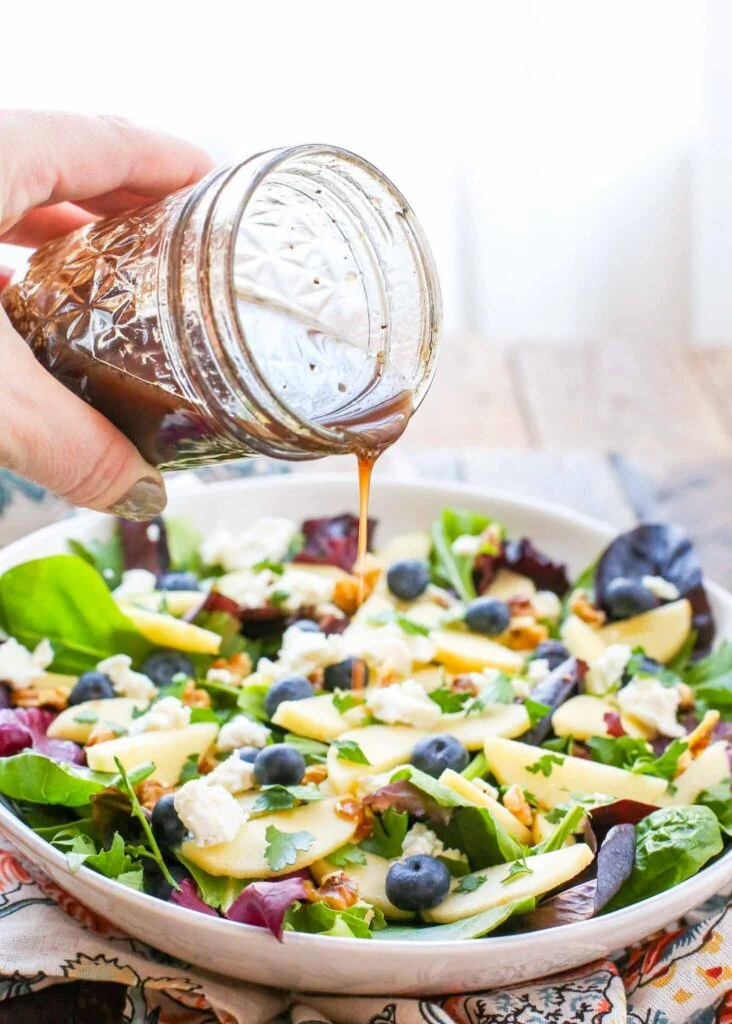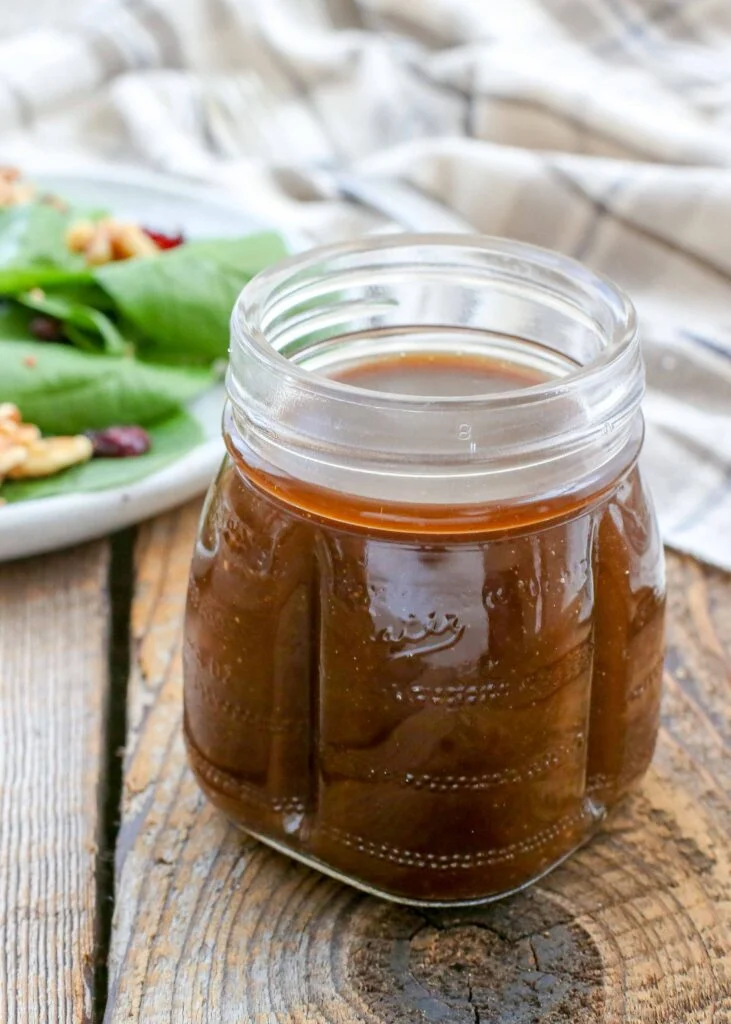Balsamic vinaigrette is one of the most versatile and flavorful dressings you can have in your kitchen. It’s tangy from the vinegar, slightly sweet from the honey, and rich from the olive oil. Perfect for salads, grilled vegetables, or even as a marinade for chicken and steak, this recipe combines simplicity with incredible depth of flavor.
This homemade balsamic vinaigrette recipe yields about 20 tablespoons, enough for several large salads or a week’s worth of meal prep. The balance of honey, mustard, garlic, and balsamic vinegar makes it irresistible and adds a gourmet touch to your dishes.
1. Best Balsamic Vinaigrette Recipe ( Yield: 20 Tablespoons )
Ingredients
- 2 tablespoons honey
- 1 tablespoon Dijon mustard
- 1/2 teaspoon fine sea salt
- 1/2 teaspoon freshly crushed black pepper, finely ground
- 1 large garlic clove, minced
- 1/4 cup balsamic vinegar
- 3/4 cup extra virgin olive oil
Instructions
Step 1: Prepare the base
Begin by selecting a medium-sized mixing bowl or a large glass measuring cup. Add the honey, Dijon mustard, minced garlic, sea salt, and freshly ground black pepper. These ingredients form the flavorful base of your vinaigrette, giving it both sweetness and tang. The Dijon mustard also helps emulsify the dressing, ensuring that the oil and vinegar blend smoothly.
Step 2: Add the balsamic vinegar
Pour in the 1/4 cup of balsamic vinegar. Use a whisk to combine the ingredients thoroughly until the honey and mustard dissolve completely into the vinegar. The vinegar not only provides acidity but also adds a deep, complex sweetness that enhances the flavor of your salads or marinades.
Step 3: Slowly incorporate the olive oil
While whisking continuously, slowly drizzle in the 3/4 cup of extra virgin olive oil. This slow addition is crucial to create a creamy, well-emulsified dressing. If you pour the oil too quickly, it may separate instead of blending. Continue whisking until the mixture looks smooth and slightly thickened.
Step 4: Taste and adjust seasoning
Once combined, give the vinaigrette a taste. If it’s too tangy, add a touch more honey. For extra sharpness, add a small splash of balsamic vinegar. Adjust salt and pepper according to your preference.
Step 5: Store and serve
Transfer the vinaigrette into a glass jar or bottle with a tight-fitting lid. Shake well before each use, as natural separation may occur over time. You can refrigerate it for up to one week. Before serving, allow it to sit at room temperature for a few minutes, then shake or whisk again to restore its smooth consistency.
Serving suggestion:
Drizzle your homemade balsamic vinaigrette over a fresh green salad, roasted vegetables, or grilled chicken. It also pairs beautifully with mozzarella, tomatoes, and basil for a simple Caprese salad.

2. Tips for Perfect Homemade Balsamic Vinaigrette
To make the best balsamic vinaigrette every time, focus on the quality of your ingredients. High-quality extra virgin olive oil and aged balsamic vinegar make a huge difference in taste and texture. The olive oil should have a mild, fruity aroma rather than a harsh or bitter flavor. Similarly, aged balsamic vinegar tends to be thicker and sweeter, adding a luxurious feel to the dressing.
Keep your proportions balanced. The general ratio for vinaigrettes is one part vinegar to three parts oil, but this recipe slightly adjusts the ratio for more flavor depth. If you prefer a tangier vinaigrette, reduce the olive oil slightly or add a touch more vinegar.
Whisking is key to emulsification. If you find it difficult to whisk by hand, you can use a blender or food processor. These tools help create a creamier consistency that won’t separate easily. Another trick is to add the Dijon mustard early—it acts as a natural emulsifier, holding the oil and vinegar together.
Garlic adds a sharp punch, but it can easily overpower the dressing if too strong. Mincing it finely or using a garlic press helps distribute the flavor evenly. For a milder taste, you can roast the garlic beforehand or substitute it with shallots.
Lastly, always taste before serving. Homemade vinaigrettes are incredibly customizable. You can add a pinch of dried herbs such as thyme, basil, or oregano for extra aroma. If you want a citrusy twist, add a teaspoon of fresh lemon juice or zest. With small tweaks, you can create endless variations tailored to your dishes.
3. Frequently Asked Questions
What is balsamic vinaigrette made of?
Balsamic vinaigrette is typically made with balsamic vinegar, olive oil, mustard, honey or another sweetener, garlic, salt, and pepper. These ingredients combine to create a tangy, slightly sweet dressing that enhances the flavor of salads and meats.
Can I make balsamic vinaigrette without mustard?
Yes, you can omit mustard if you don’t have it, but it helps emulsify the dressing and adds depth of flavor. If you skip it, shake the dressing well before each use to keep the oil and vinegar blended.
How long does homemade balsamic vinaigrette last?
When stored in an airtight container in the refrigerator, it can last up to one week. Always shake before using, as natural separation is normal.
Can I use another type of vinegar?
Absolutely. You can substitute balsamic vinegar with red wine vinegar, apple cider vinegar, or sherry vinegar. Each type brings its own unique flavor—apple cider vinegar adds brightness, while red wine vinegar gives a sharper tang.
Is balsamic vinaigrette healthy?
Yes, in moderation. It’s made with heart-healthy olive oil and natural sweeteners like honey. It’s far healthier than most store-bought dressings, which often contain preservatives and added sugars.
Can I make a creamy version?
To create a creamy balsamic vinaigrette, blend in a tablespoon of Greek yogurt, mayonnaise, or avocado. This adds richness and makes the dressing thicker and smoother.

4. Nutrition Information
| Nutrient | Per Tablespoon |
|---|---|
| Calories | 95 |
| Total Fat | 10.2 g |
| Saturated Fat | 1.4 g |
| Cholesterol | 0 mg |
| Sodium | 80 mg |
| Total Carbohydrates | 2.2 g |
| Sugars | 1.8 g |
| Protein | 0.1 g |
Homemade balsamic vinaigrette is an easy and elegant addition to your kitchen repertoire. With just a few ingredients and minimal effort, you can create a flavorful dressing that outshines any store-bought version.
